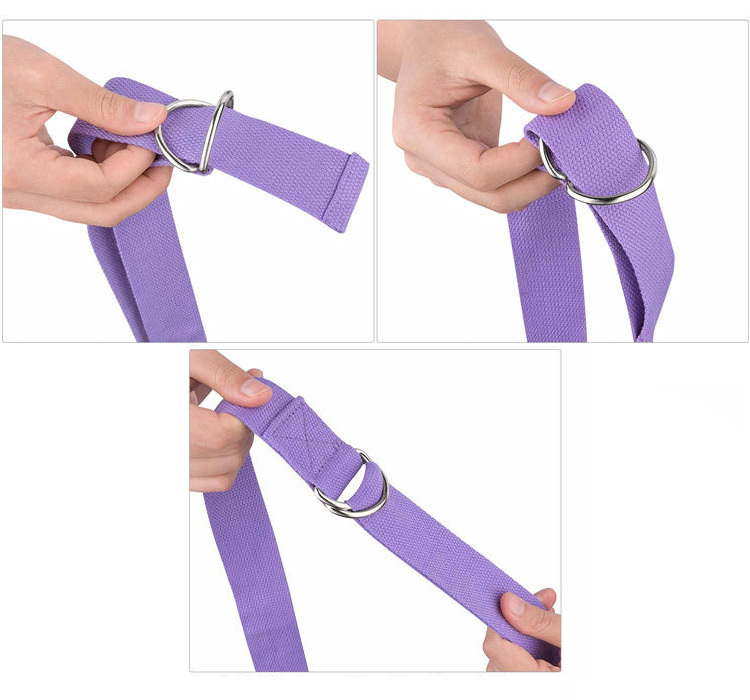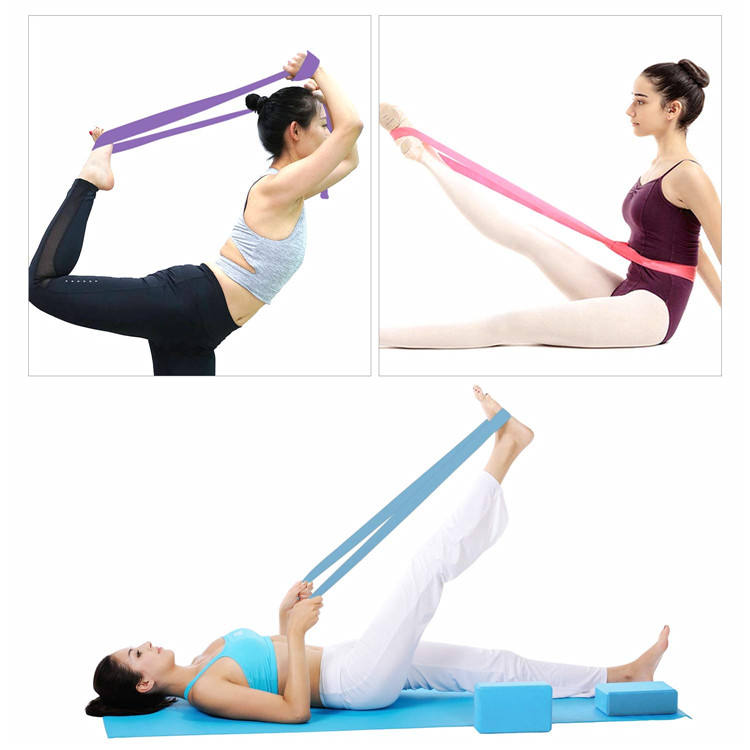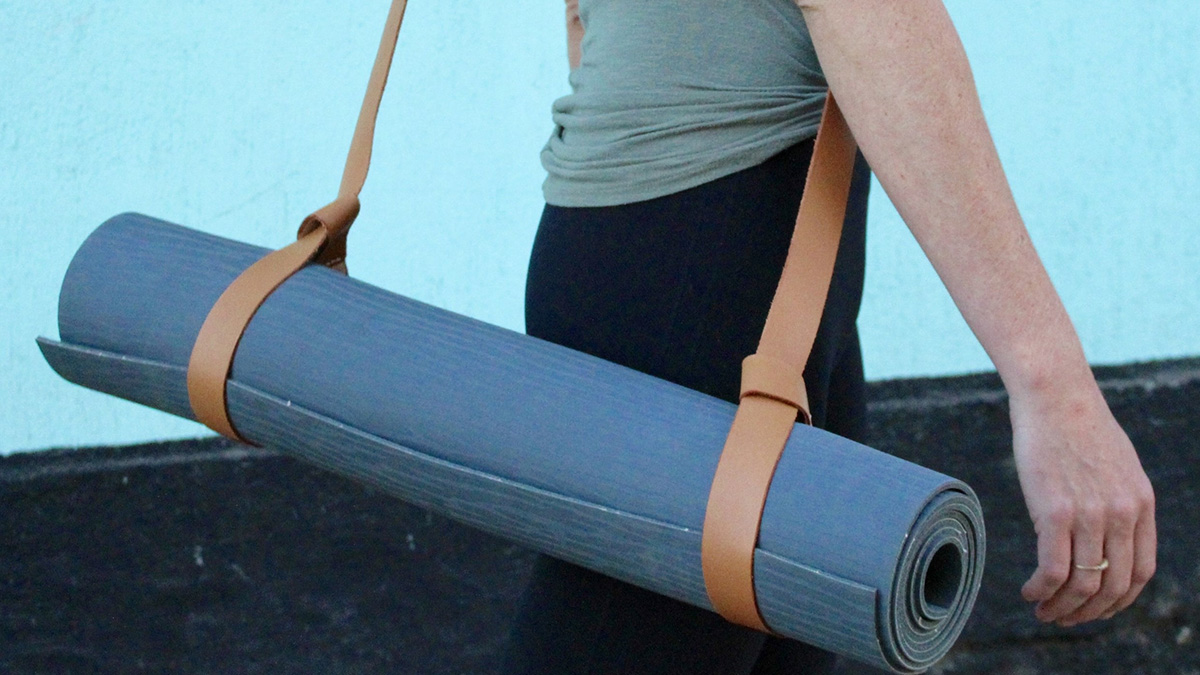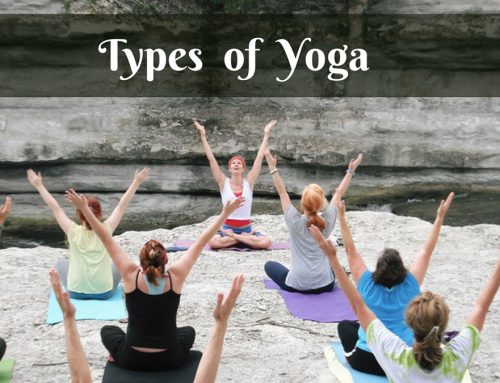Whether you take the bus or ride your bicycle to yoga class, you have to carry your yoga mat with you. An easy way to carry it is simply roll it and put it in the back of the car. However, chances are that the mat will stretch and even restore to its original shape (especially when the mat is made of natural rubber) without external pressure, and sometimes you may not drive yourself. It is a must for you to keep the mat rolled up when either stored or carried. When it comes to this problem, a yoga mat strap can offer you great help. How to tie yoga mat with strap? In this article, Speck will show you the best tying method.
I. How to Tie Yoga Mat with Strap
Step 1: Use your left hand to grasp the buckle or the metal hoop end, and use your right hand to take the fabric loop end of your mat.
Step 2: Thread the fabric loop end in your right hand through metal hoops and immediately thread the loop end back through the farthest buckle or hoop.
Step 3: Pull approximately 1/2 the length of the yoga mat strap through the buckle or the hoop. And now you have a big loop of the strap in your left hand and a fixed fabric loop in the right hand.
Step 4: Thread the larger loop through the smaller one and keep pulling the strap through before a small circle appears around your rolled mat in the other end of the yoga mat strap.
Step 5: Hold the mat-sized loop firmly in the left hand and make sure the map-sized loop will not change sizes. Now catch the big loop at the other end of the mat strap — approximately 8 to 10 inches away from the fold with your right hand.
Step 6: Next, poke the loop in your left hand through the one created when catching the other end of the yoga mat strap. Again make sure the mat-sized loop is grasped firmly.
Step 7: Switch you hands. You are supposed to use several fingers to snag the mat-sized loop and transfer it to your right hand. Then, use your left hand to adjust the second loop the same way as you have made the first mat-sized loop.
Step 8: Slip one loop over its related end of the mat and snug the loop tightly. Next, slip the other loop and repeat the same process. Congratulations! You have managed to tie your yoga mat with a strap!
Step 9: Place the rolled mat over your shoulder, and you can take it anywhere you go.

II. How to Practice Yoga with Strap
- Side Stretch
Side stretch is often performed before yoga exercises to fully stretch your shoulders, arms and all sides of the body. In order to do that, you have to hold your mat strap a little bit wider than your shoulder width swaying slowly with your breaths and stretching yourself side by side.
- Opening Your Shoulders
Opening your shoulders is also a pre-exercise practice that can pave the way for your workouts. Again, hold your mat strap a little bit wider than your shoulder width. Bring your arms straight towards the front and take them back slowly. In order to make sure that your movement stays standard and comfortable, you should keep your hands wide enough on the mat strap.
- Paschimottanasana
Paschimottanasana is a kind of asana that is also called Seated Forward Bend. First, you need to sit down and place the strap around your feet balls. With straightened legs and strap, you can open up your hamstrings by sticking to this posture. It is advised that you softly pull yourself forward but avoid a round back.
- Bound Angle Pose
Bound angle pose helps to stretch inner thighs and hips. Here is what you should do. Make a loop from the strap and put the loop around your sacrum and under your feet. Tighten the strap and you will find that your legs are pulled to the body. You can open your hips while nailing this posture.
- Reclining Leg Stretch
You ought to lay down before lifting one of your legs with the strap placed on the ball of the lifted foot. Slowly lift your foot towards the sky and use your hands to tighten the leg. In order to make sure that your shoulders are comfortable, you can keep your elbows on the floor/mat. Also, it is the middle part of the strap that should be placed on your foot, and you can turn to the other leg every 10 minutes of training.
- Extended Hand to Big Toe
This posture also helps to stretch your hamstrings. Simply make a loop from the strap and place one of your feet into the loop. It should be noted that the loop must be made at the end of the strap. Then, raise the knee and stick to the posture with the hand on the same body side. Slowly straighten the strap with your hand and you can put the other arm around your waist. Hold on to this posture for at least 5 minutes before switching to the other foot. But, if you feel extremely uncomfortable, stop this posture at once.
- Natarajasana
Natarajasana is often adopted by dancers as an effective posture to enhance flexibility, hence the common name “Dancers’ Pose”. Make a loop at the end of the mat strap and put one of your feet into the loop. You can stand against a wall in case of falling. Raise your hands while holding the other end of the strap, pointing your elbows towards the ceiling. Press on the shoulder strap and start walking along the shoulder strap to make it shorter.
- Janu Sirsasana
This asana is also called the Head-to-Knee Pose. You should start in Dandasana bending your right leg and taking the foot close to the inner thigh of your left leg. Make a loop from your mat strap and put it around the ball of your left foot. While holding on the strap, you should gently bend yourself to the extended left foot until you have reached the limit. Again, do not force yourself to do this asana in case of injury.
- Gomukhasana Arms
Put your left arm behind the back and you right arm behind the neck while holding onto the strap with both of your hands. Pull the strap in opposite directions and feel the extension of this pose.
Do what you can to stretch you shoulders. But if you have sensitive joints, it would be better for you to try other asanas as this one really challenges your arms and shoulders.
- Navasana
Navasana, including Half and Full Boat Pose, is the most difficult asana among the ten, requiring both core strength and balance. Place the mat strap beneath your feet balls and catch two ends of the strap. Lift up your legs slowly while keeping your back stay extended rather than rounded. Push your feet onto the strap. Keep your knees bent and your shins parallel to the ground for a Half Boat Pose. If you are a master, try and nail the Full Boat Pose.

III. Different Ways of Using a Yoga Strap
Except for rolling the yoga mat, yoga strap is designed to offer three major functions, namely, alignment, deepening and lengthening. Proper and right use of yoga strap is conducive to enhancing yoga performance in a secure and effective way.
- Alignment
Yoga strap is capable of correcting your alignment. Essential asanas such as Navasana (described above) and Chaturanga can be corrected and improved with the help of a yoga strap. This small yet practical strap helps you experience the right feeling for nailing a pose, so that it would be easier for you to adjust your postures based on the right feeling when practicing yoga asanas. In this way, the risk for injury like muscle cramps and joint dislocations greatly decreases, and you can tap your potential to hold on to full poses.
- Deepening
Another key benefits of using a yoga strap for exercising is that it enables you to deepen stretches and poses such as Paschimottanasana (also named as Seated Forward Bend or Seated Forward Folds). You are full of potential, and a yoga strap tries to dig that potential in you as you deepen every pose until you have reached the ceiling. The first function of yoga strap helps you to correct your poses while the second one advances and deepens them in the right direction.
- Lengthening
The last function of yoga strap is that its lengthening capability allows you to avoid painful and potentially dangerous compression. For example, if you are a yoga beginner trying to do Bow Pose, you are expected to feel the difficulty of this pose. On the contrary, a yoga strap can help you gradually break in without laying too much pressure on your spine, and your legs will accordingly enjoy a broader range of movements and are capable of stretching higher.
Speck is the leading yoga mat manufacturer in China. If you have any questions on custom yoga exercise mats, please do not hesitate to send email to sales@yogafitness.group.
Do You Want To Source Custom Design Yoga Mat?
Drop Us An Email And You Will Receive Our Feedback Within 24 Hours.
As a leading yoga mat manufacturer, Speck Group focuses on innovation, quality, simplicity, and sustainability.






